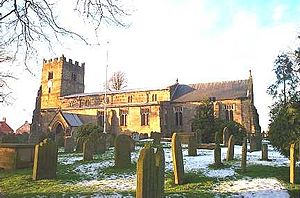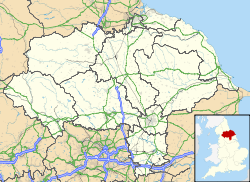- St John and All Saints' Church, Easingwold
-
St John and All Saints' Church, Easingwold 
St John and All Saints' Church, Easingwold, from the southLocation in North Yorkshire Coordinates: 54°07′25″N 1°11′51″W / 54.1236°N 1.1974°W OS grid reference SE 526 700 Location Easingwold. North Yorkshire Country England Denomination Anglican Website St John and All Saints, Easingwold History Dedication Saint John the Baptist
All SaintsArchitecture Status Parish church Functional status Active Heritage designation Grade II* Designated 17 May 1960 Architect(s) E. G. Paley (restoration) Architectural type Church Style Gothic Administration Parish Easingwold with Raskelf Deanery Easingwold Archdeaconry York Diocese York Province York Clergy Vicar(s) Revd Canon John Harrison St John and All Saints' Church, Easingwold is located in the town of Easingwold. North Yorkshire, England. It is an active Anglican parish church in the deanery of Easingwold, the archdeaconry of York, and the diocese of York. Its benefice is united with that of St Mary, Raskelf.[1] The church has been designated by English Heritage as a Grade II* listed building.[2]
Contents
History
The present church dates mainly from the 15th century, although it contains possible remains of older fabric and a re-set 12th-century doorway.[2] In 1853 a porch was added by the Lancaster architect E. G. Paley, and in 1858 the church was restored by the same architect.[3]
Architecture
Exterior
The church it constructed in ashlar. The roof of the chancel is slate; the roofs elsewhere are covered in lead. The plan of the church consists of a five-bay nave with a clerestory, north and south aisles, a south porch, a three-bay chancel, and a west tower. The tower is in three stages, with angle buttresses and an embattled parapet. It originally had an open west porch, but this has been blocked and a door and a window have been inserted. The windows on the sides of the nave and chancel have two lights with panel tracery, and are flat-headed. The east window has three lights with Decorated tracery. The re-set 12th-century doorway is in the north wall of the nave.
Interior
Inside the church the arcades are supported by octagonal piers. The church contains a monument dated 1713 with Ionic pilasters, a broken pediment and a hatchment.[2] The two-manual organ was made in 1903 by Abbott and Smith of Leeds, and was restored in 1990 by Principal Pipe Organs.[4] The ring consists of eight bells. The oldest five bells date from 1788 and were cast by Robert Dalton, one bell dates from 1887 and is by John Warner & Sons, and the latest three bells were cast in 1950 by Gillett & Johnston.[5]
See also
- List of ecclesiastical works by E. G. Paley
References
- ^ St John and All Saints, Easingwold, Church of England, http://www.achurchnearyou.com/easingwold-st-john-all-saints/, retrieved 23 August 2011
- ^ a b c Church of St John, Easingwold (1294335). National Heritage List for England. English Heritage. Retrieved 23 August 2011.
- ^ Price, James (1998), Sharpe, Paley and Austin: A Lancaster Architectural Practice 1836–1942, Lancaster: Centre for North-West Regional Studies, p. 74, ISBN 1-86220-054-8
- ^ Yorkshire, North Riding (Yorkshire, North), Easingwold, St. John the Baptist and All Saints, Church Hill (A00889), British Institute of Organ Studies, http://www.npor.org.uk/cgi-bin/Rsearch.cgi?Fn=Rsearch&rec_index=A00889, retrieved 23 August 2011
- ^ Easingwold, S John Bapt & All Saints, Dove's Guide for Church Bell Ringers, http://dove.cccbr.org.uk/detail.php?searchString=easingwold&Submit=+Go+&DoveID=EASINGWOLD, retrieved 23 August 2011
Categories:- Church of England churches in North Yorkshire
- Diocese of York
- Grade II* listed churches
- Grade II* listed buildings in North Yorkshire
- English Gothic architecture
- E. G. Paley buildings
Wikimedia Foundation. 2010.

